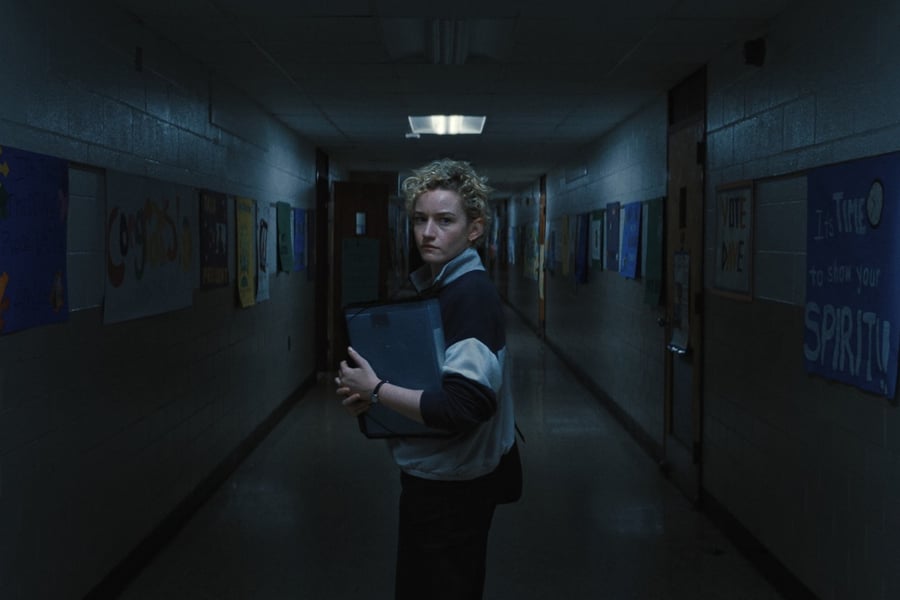The clock strikes 2:17 am, and as if heeding some sort of Pied Piper’s call, 17 children run away. They just get up out of their beds, flee their houses and, arms akimbo, bolt into the night. No one has a clue as to where these kids went. The only connection is that they were all part of the same third grade class. “This is a true story… it happened in my home town,” says an unnamed youngster. (Pop culture nerds may note the voiceover sounds oddly similar to the narration that opens the 1980 exploitation classic Shogun Assassin and is sampled on GZA’s “Liquid Swords.”) Then comes the kicker: “A lotta people die in a lotta weird ways.” You have no idea what an understatement that last sentence will turn out to be.
This is one of the few plot points of Weapons, writer-director Zach Cregger’s follow-up to his 2022 sleeper hit Barbarian, that can be discussed without fear of spoiling several whiplash-inducing twists and turns. It’s the central tenet of the movie’s cryptic marketing campaign and the catalyst for its mystery, which will end up being rewound, revised and reframed from a variety of different viewpoints before everything’s revealed. Yet these macabre scenes of eight- and nine-year-olds sprinting through darkness, set to George Harrison’s “Beware of Darkness,” are so eerily poetic that you’ll find yourself getting chills simply from the memory of them. The images will haunt you long after the final puzzle piece is dropped in to complete the picture. And if Cregger’s previous movie proved he knew how the withholding of information and slow turning of screws can conjure up dread, this ambitious, multi-strand thriller demonstrates an expert facility in tapping directly into that part of your consciousness where nightmares reside. He’s made good on the promise hinted at from that Air BnB horror flick. The dude is the real deal.
A month after the kids have vanished without a trace, the small town of Maybrook remains in a state of panic and paranoia. Parents turn PTA meetings into potential powderkegs. Neither the police nor the school’s principal (Benedict Wong) have any answers. Much of the community’s anger is directed toward Justine Gandy (Julia Garner). A relative newcomer to Maybrook, Ms. Gandy is the teacher who walked into her classroom one day to inexplicably find 17 of her students missing; the idea that she’s the only link between the missing children makes her a prime suspect. Only one of her third-graders, a quiet kid named Alex (Cary Christopher), showed up the morning after the incident. No one knows why he seems to have been spared.
Given the volatile situation — and an act of vandalism that resulted in “Witch” being painted on the side of her car — Justine is asked to take a leave of absence for her own safety. She’s also told not to communicate with Alex, despite the fact that she thinks he knows something about what happened. Meanwhile, a contractor named Archer Graff (Josh Brolin), whose son is among the M.I.A., mounts an investigation of his own. After reviewing footage taken from door cams from the night of the Great Maybrook 2:17am Disappearance, he manages to triangulate a possible final destination for the nocturnal tweens. Coincidentally, the location is in the same neighborhood as a house that Justine had visited a few days before, one with newspaper covering up all of the windows… .
No sooner have viewers come close to getting a grasp on who, what, where, and the holy grail that is the “why” behind Weapons‘ tragedy then Cregger pauses at a key moment, switches angles, and hits the reset button. We get to see things unfold from Justine and Archer’s respective perspectives, which soon begin to merge. The filmmaker also adds in storylines that focus on Andrew, the school’s under-pressure principal; Paul (Alden Ehrenreich), a recovering-alcoholic cop who has a history with Justine; Anthony (Austin Abrams), a drug-addicted drifter passing through town; and Alex. Each chapter ends on the equivalent of a cliffhanger, which leads folks to wonder who strangely somnambulistic figures might be, the reason that one character is running full-tilt to attack another character (funny how his arms are akimbo, where have we seen that before?); and why some peripheral presence in what appears to be clown makeup keeps showing up in people’s dreams.
There will likely be some folks who think this approach, which Cregger has mentioned was partially inspired by the format of Paul Thomas Anderson’s Magnolia, requires too much work. Or that, like Barbarian, it favors shocks and width over depth. Or that the constant rail-switching between individual POVs keeps slowing things down — to which we’d reply that a rollercoaster is usually a slow ride as it makes its ascent, causing riders to feel the anticipation of what’s to come all that more nerve-racking, nausea-inducing and thrilling. Then the cars crest that first hump and head toward the drop, and away you go. Without mentioning any specifics, we can assure you that the abundance of bit-by-bit build-up gives way to a massive pay-off, including a climactic series of set pieces that rewards the patient. There’s a constant refrain of “what the fuck?!” that comes from the movie’s many characters throughout. You’ll hear more than one audience member screaming those same three words during the final 10 minutes.
More importantly, however, is the fact that Cregger never lets the complicated, ever-morphing narrative get too tangled up in itself even when it leads you down unexpected detours. This is a tale that’s carefully crafted as much as told, with hints hiding in plain sight and surreal touches that add more to the vibe than the momentum. But you never feel like you’re in the hands of someone who doesn’t know exactly what he’s doing. And thanks to cinematographer Larkin Seiple’s ability to visually balance the banal and the bizarre (he also shot Everything Everywhere All at Once and Swiss Army Man) and the cast, all tuned in to the same wavelength of weird here (though a big shout-out to Christopher, who gives Alex’s story a genuine undercurrent of pain), there’s a real coherence to the horror. Weapons wants nothing more than to jolt you out of a sense of complacency — to remind you that manipulative forces exist, and not even basic explanations can wash away the concept of chaos hovering just outside of the frame. In that sense, it’s aim is true.
Love Music?
Get your daily dose of everything happening in Australian/New Zealand music and globally.
From Rolling Stone US



































